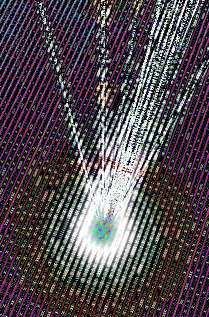Hybrid chips for light computing
 Australian researchers are working on photonic chips that have huge potential for the future of computers and telecommunications.
Australian researchers are working on photonic chips that have huge potential for the future of computers and telecommunications.
Photons are already the gold standard for intercontinental communication through fibre-optics, and they are beginning to replace electrons as the main carriers of information in the very heart of computers themselves.
But here are some substantial engineering barriers in the transition to full photon computing.
Industry-standard silicon circuits that support light are more than an order of magnitude larger than modern electronic transistors. One solution is to ‘compress’ light using metallic waveguides – however this would not only require a new manufacturing infrastructure, but also the way light interacts with metals on chips means that photonic information is easily lost.
But now, scientists in Australia and Germany have developed a modular method to design nanoscale devices to help overcome these problems, creating a hybrid of traditional chip design and photonic architecture.
“We have built a bridge between industry-standard silicon photonic systems and the metal-based waveguides that can be made 100 times smaller while retaining efficiency,” says lead author Dr Alessandro Tuniz from the University of Sydney.
This hybrid approach allows the manipulation of light at the nanoscale, measured in billionths of a metre. The scientists have shown that they can achieve data manipulation at 100 times smaller than the wavelength of light carrying the information.
“This sort of efficiency and miniaturisation will be essential in transforming computer processing to be based on light. It will also be very useful in the development of quantum-optical information systems, a promising platform for future quantum computers,” said Associate Professor Stefano Palomba, a co-author from the University of Sydney.
“Eventually we expect photonic information will migrate to the CPU, the heart of any modern computer.”
Such a vision has already been mapped out by IBM.
The team has found that that two separate designs can be joined together to enhance a run-of-the-mill chip, allowing for rapid rotation of light polarisation in the chip and, because of that rotation, permitting nano-focusing down to about 100 times less than the wavelength.








 Print
Print